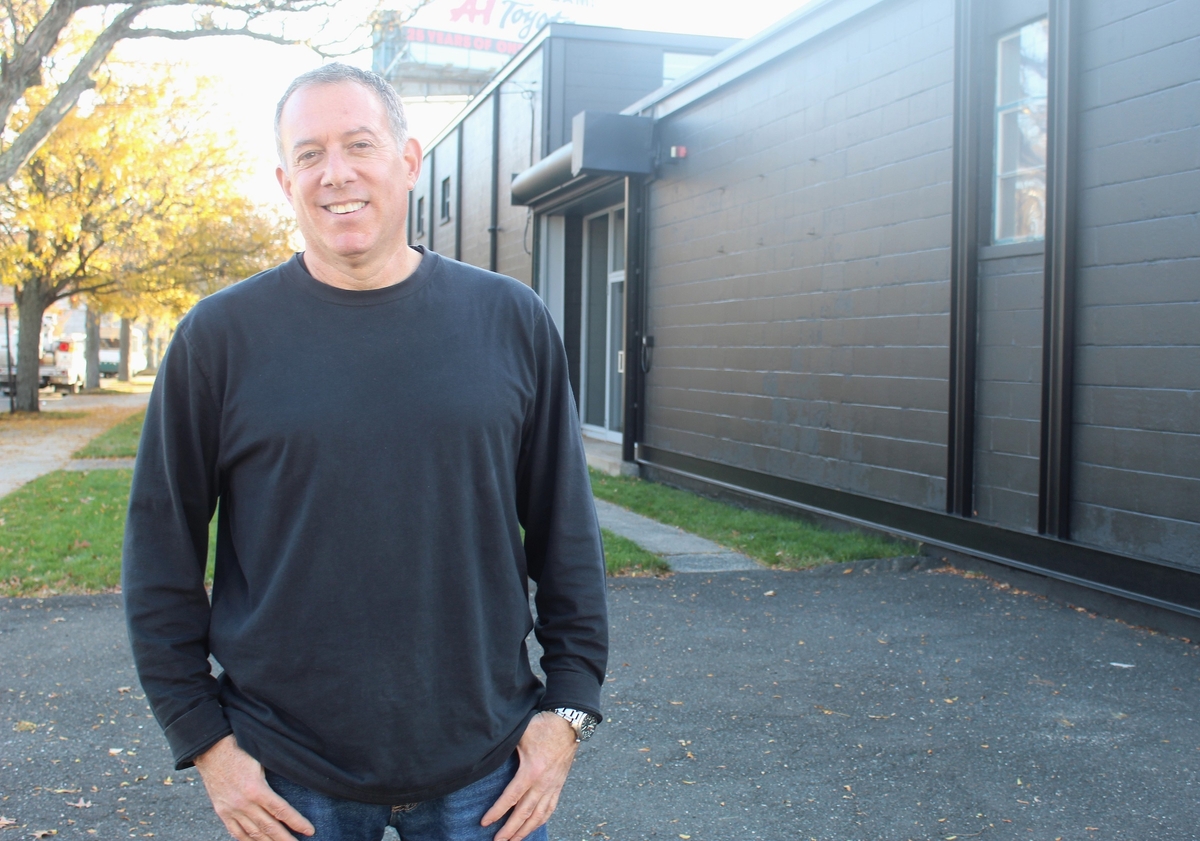
Tom Breen photo
Greenberg outside 80 Hamilton: "It'll be a magical place for New Haven."
A local artist and historian with a knack for finding lost artifacts has won a key city approval to convert a former Hamilton Street warehouse into his next curatorial space for Elm City ephemera.
New Haven’s City Plan Commission voted unanimously during its latest Wednesday night Zoom meeting to grant Robert Greenberg, who founded the nonprofit Lost in New Haven Inc., site plan approval as he seeks to turn an industrial property at 80 Hamilton St. into a museum and events room.
The local land-use commissioners voted unanimously in support of Greenberg’s nonprofit’s site plan application for the “change of use of an existing vacant industrial building to a museum, with associated site improvements in” an industrial zone, to quote directly from the City Plan Commission’s agenda.
On Wednesday, city planner Esther Rose-Wilen reported that Greenberg’s project proposal went through technical review with city staff but “only needed one review session because the applicant was so responsive to comments.”
The now-approved site plan application states that the construction work needed to convert this space into a museum is “limited to installation of underground stormwater management and striping of existing parking lots.” Greenberg has also already repainted the exterior of the building black.

Outside 80 Hamilton ...

... and inside the future museum's front entrance.
Once officially open, this will be the third space occupied by Greenberg and his collection of New Haven memorabilia and artifacts. That collection was originally housed at Crown Street’s ACME Furniture building, which his grandfather founded in 1912 upon immigrating to the States from the border of Poland and Russia. (That store has subsequently closed, and will soon be eco-friendly apartments.)
Following a lease termination at Lost in New Haven’s most recent home on Grand Avenue, Greenberg said of his Wednesday night win that “the hurdle I overcame was a big one and I appreciate the green lights they threw to me.”
“I’ve overcome another hurdle and we’ll keep doing it ‘til we get to the finish line,” he continued. However, he added, his New Haven history preservation project will likely always be changing and updating and, at least in a design sense, will “never be done.”
Greenberg is still adding to his collection of New Haven treasures, which currently includes objects ranging from the old Cutler’s record store sign to World War I military recruitment posters from Church Street to relics from the now mostly demolished former Bigelow Boiler Factory complex to Sally’s pizza boxes, Bradley Smith Co. lollipop tins, New Haven Nighthawks hockey pucks, late 19th-century porcelain teacups, and early 20th-century New Haven police photographs.
“Personally, I think Hamilton is the bullseye, it’s the perfect spot,” Greenberg said of his new property, which his nonprofit purchased for $1 million in August thanks to a loans from a few different donors. “From Fair Haven to Wooster Square to Long Wharf, there are great walking tours,” he reflected. “It’s a perfect bicycle tour location,” he added, noting that the property will have at least eight spaces for bike parking. And another important plus, Greenberg noted, is that easy bus access to the Hamilton site may encourage and facilitate student visits.
An alum of New Haven schools himself, Greenberg said that engaging youth in New Haven history is one of his primary goals. He said his affinity for gathering and studying physical pieces of New Havens past began as a child when he would accompany his grandfather Simon Evans to flea markets and festivals. There, Evans would often set up his own exhibits of artifacts for the sake of “conversation and memory,” Greenberg recalled.
“I helped him set up, not understanding what I was seeing,” he remembered. “But I remember seeing tears in peoples’ eyes,” he said, as passerby considered the impacts of urban renewal on their community just by looking at a pile of old signage or remnants of bulldozed homes.
Today, it is more often adults than children, Greenberg added, who struggle to understand and categorize Greenberg’s unusual and hard-to-label collection of odds and ends.
During Wednesday’s discussion at the City Plan Commission meeting, Chair Leslie Radcliffe sought clarity on that very question: “What kind of museum is this?” she asked.
“It’s an eclectic collection of historic New Haven items, if you will,” Greenberg’s project’s engineer, Marcus Pottuck, offered as explanation.
A description of some of New Haven’s first-ever installed elevators and old rock n’ roll memorabilia from the city’s music venues that will be displayed in the upcoming museum was more than enough to get commissioners on board.
“I think a museum that highlights some of the industrial pasts of the city,” Commissioner Adam Marchand said, “sounds really wonderful.”
“I’ve been a resident of New Haven for quite a long time,” Radcliffe pitched in, “But I’m sure there were things that were here before me.”
Greenberg said that he hopes his Hamilton Street space will serve as a “great hub for tourism.” Those who visit his space, he said, whether out-of-towners or the city’s own students, will be advised by unofficial community-liaison Greenberg about where to travel next — be it museums, historic sites, or archaeological digs — in the city to learn more about New Haven.
“It’ll be a magical place for New Haven,” he said.





I am SO looking forward to touring this eclectic collection of all things New Haven.